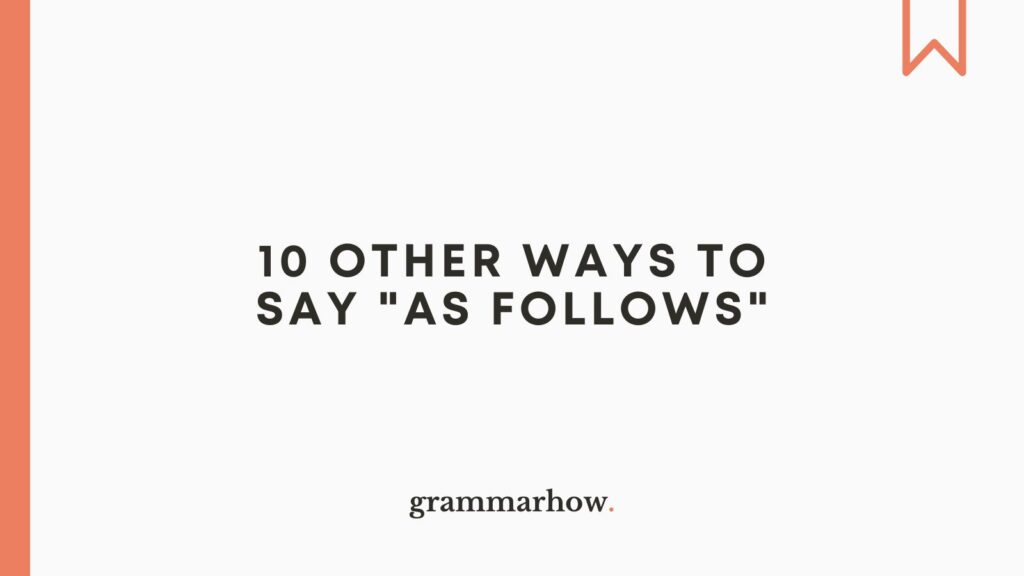Are you trying to spice up your writing and avoid repeating “as follows” too much?
In this article, we’ll share some great alternatives that will teach you a different way to say “as follows.” It’s time to explore exciting new synonyms to engage your readers.
- See below
- The following is
- As detailed below
- As indicated below
- In the following manner
- According to the following
- As you will see
- As outlined below
- From the following
- Listed below
Keep reading to learn what to write instead of “as follows.” We’ve provided examples for every alternative in the list above!
1. See Below
“See below” shows you a different way to say “as follows.” It works well when you’ve attached an informative file.
Generally, “below” here refers to the file in question. It works well in formal emails, as it directs the recipient’s attention to the file you’d like them to review.
It can work well when contacting employees. Try it the next time you’d like them to review an important document to help with their work.
You can also refer to this email example:
Dear Russell,
I have attached a file that will explain everything you need to know about this. Please see below.
Yours,
Duncan Redford
2. The Following Is
For a more direct list, you can use “the following is.” It’s a great choice for a formal alternative, so it’s bound to work quite well in your emails.
Try it when emailing a client. It shows you’re on top of something and want them to review a list before you can do business with them.
Here’s a great sample email to show you how it works:
Dear Miss Scott,
The following is a list of everything we need to account for before moving forward. Please consider all the options first.
Thank you so much,
Barry Onion
3. As Detailed Below
It’s worth using “as detailed below” as another way to say “as follows.” Again, it refers to an attached file that contains important information for a recipient.
Try including it when emailing an employer. It shows you would like to share something with them and want their verdict on the information you provided in an email.
Generally, “detailed” means you have included a lot of information. It refers to many details, which will often help the recipient understand more about what you’re asking.
We also recommend reviewing this example:
Dear Mr. Tayler,
As detailed below, these are the most important things for us to complete. Do you think you can help us with this?
All the best,
Sophie Miller
4. As Indicated Below
Indicating specific information or updates helps recipients to understand what’s happening. That’s why “as indicated below” is a good alternative to “as follows.”
It allows you to direct someone’s attention to important updates. This will help you establish a formal conversation with them and allow them to see what you have to say.
However, as with any option that includes “below,” it only works when providing an attachment. As “below” often refers someone directly to an attached file.
Perhaps this email example will also help you:
Dear Mr. Dunkirk,
I have attached the document as indicated below. I would certainly like to hear your opinion on matters.
Best,
Sam Young
5. In the Following Manner
You can use “in the following manner” to begin a list. It’s a good way to let a recipient know what to expect from the next few lines of an email.
It’s not quite as direct as “as follows.” It usually requires a bit of build-up to get it right.
However, it’s a good way to lay out information concisely. This should help the recipient to understand what you’re conveying.
You can also review the following example:
Dear Miss Sutton,
I will refer you to the most important matters. In the following manner, you should learn the most pressing issues first.
Yours,
Michael Shearer
6. According to the Following
We also recommend using “according to the following.” It’s a great formal synonym for “as follows.”
It shows you would like to refer to specific information that follows your current statement. This will help the reader to understand what you’re hinting at as they read an email.
For instance, you can use it when emailing employees. It shows you have a specific document or list of information you’d like them to abide by.
Check out this email example if you’re still unsure:
Dear Anthony,
You need to work on this project according to the following rules. Do you think that’s in your wheelhouse?
My best,
Sonia Burton
7. As You Will See
It’s good to use “as you will see” to direct someone’s attention to information.
It shows that you will follow an email with an attachment or information that will benefit the reader.
This is a great way to ensure the reader focuses. It will let them know that they will “see” what’s important as long as they review the list or information you provide next.
This sample email will also help you:
Dear Miss Pickett,
As you will see from the file below, we’d like to discuss whether the next steps are the most appropriate.
Kind regards,
Sean Bentley
8. As Outlined Below
You can use “as outlined below” as a formal synonym for “as follows.” It works really well when you’ve detailed the flow of a project.
Generally, this works well when emailing employees. It shows you have an outline for them to follow, and you’d appreciate it if they could review it.
It’s also not too direct. It simply lets them review the attachment “below” the email, which should help them to figure out what they need to do with the outline.
Also, here’s a great example to show you how it works:
Dear Sharon,
We are working on this as outlined below. Please let us know if there’s anything you’d like to change.
Yours,
Martin Samson
9. From the Following
Try using “from the following” to explain how important information is. We recommend using it in emails to let a recipient know they should focus on your writing.
Generally, this is a good way to communicate with clients. It shows you’re interested in filling them in, similarly to how “as follows” works.
You can provide a list before or after “from the following,” making it a versatile choice when sharing important information.
Why not check out the following example as well:
Dear Miss Vasiljeva,
What can you gather from the information we’ve attached? It’s important to read through it to learn from the following.
My best,
Hillary Clyde
10. Listed Below
Finally, you can use “listed below” instead of “as follows.” It’s a great way to end a sentence when you’d like to introduce a list to the reader.
It’s a different way to say “as follows” that works best when a list gets used. It is clear and direct, making it much clearer when the reader is trying to understand you.
Here’s a great email sample to help you with it:
Dear Mr. Quincannon,
I have created the most important rules. You will find them listed below, but I’d like to hear your thoughts.
Kind regards,
Seamus O’Doherty
Is It Correct to Say “As Follows”?
It is correct to say “as follows.” It works well before listing something in your writing.
You should know how to end a sentence with “as follows.” We recommend using it in formal writing. It allows you to express a list that immediately follows your previous sentence.
Generally, this makes things easier for the reader to follow. So, give it a go when you’re unsure how else to build into a list.
Also, you can review these examples to find out how to use “as follows” in a sentence:
- The changes we made are as follows: We will no longer serve lunch on Fridays; everyone must attend a Saturday meeting.
- The rule reads as follows. You are no longer permitted to work alongside her.
You should always use “follows” here because of how the verb form works. It’s never correct to say “as follow.” For instance:
- Correct: The changes are as follows.
- Incorrect: The rules are as follow.
It’s also incorrect to change the verb form to “following” or “followed.” For example:
- Incorrect: The changes are as the following.
- Incorrect: We would like to change things as followed.
It’s most common to place a colon or period after “as follows.” Generally, you would not need to place a comma before or after when trying to punctuate it appropriately.
The colon is the most effective when introducing a list of more than one item. However, you can use a period instead if you’d like to end the sentence.
Generally, semicolons and commas are unnecessary. To avoid confusion, it’s best to leave them out when writing “as follows.”

Martin holds a Master’s degree in Finance and International Business. He has six years of experience in professional communication with clients, executives, and colleagues. Furthermore, he has teaching experience from Aarhus University. Martin has been featured as an expert in communication and teaching on Forbes and Shopify. Read more about Martin here.

